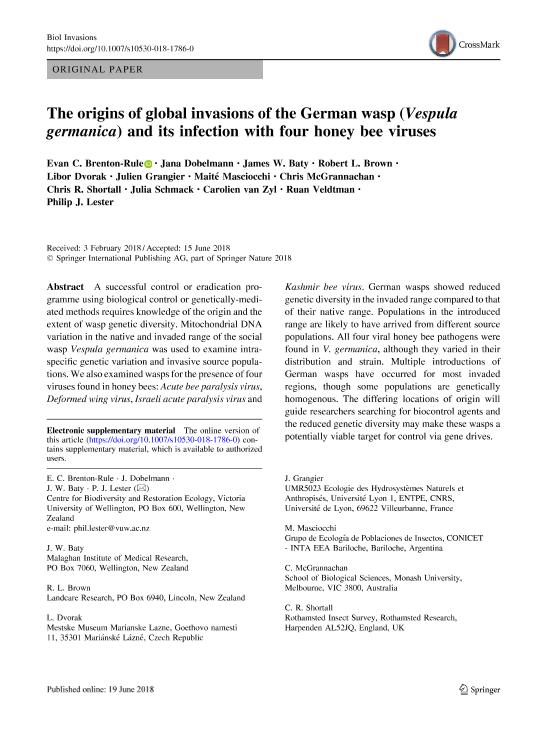Artículo
The origins of global invasions of the German wasp (Vespula germanica) and its infection with four honey bee viruses
Brenton Rule, Evan C.; Dobelmann, Jana; Baty, James W.; Brown, Robert L.; Dvorak, Libor; Grangier, Julien; Masciocchi, Maité ; McGrannachan, Chris; Shortall, Chris R.; Schmack, Julia; van Zyl, Carolien; Veldtman, Ruan; Lester, Philip J.
; McGrannachan, Chris; Shortall, Chris R.; Schmack, Julia; van Zyl, Carolien; Veldtman, Ruan; Lester, Philip J.
 ; McGrannachan, Chris; Shortall, Chris R.; Schmack, Julia; van Zyl, Carolien; Veldtman, Ruan; Lester, Philip J.
; McGrannachan, Chris; Shortall, Chris R.; Schmack, Julia; van Zyl, Carolien; Veldtman, Ruan; Lester, Philip J.
Fecha de publicación:
06/2018
Editorial:
Springer
Revista:
Biological Invasions
ISSN:
1387-3547
Idioma:
Inglés
Tipo de recurso:
Artículo publicado
Clasificación temática:
Resumen
A successful control or eradication programme using biological control or genetically-mediated methods requires knowledge of the origin and the extent of wasp genetic diversity. Mitochondrial DNA variation in the native and invaded range of the social wasp Vespula germanica was used to examine intraspecific genetic variation and invasive source populations.We also examined wasps for the presence of four viruses found in honey bees: Acute bee paralysis virus, Deformed wing virus, Israeli acute paralysis virus and Kashmir bee virus. German wasps showed reduced genetic diversity in the invaded range compared to that of their native range. Populations in the introduced range are likely to have arrived from different source populations. All four viral honey bee pathogens were found in V. germanica, although they varied in their distribution and strain. Multiple introductions of German wasps have occurred for most invaded regions, though some populations are genetically homogenous. The differing locations of origin will guide researchers searching for biocontrol agents andthe reduced genetic diversity may make these wasps a potentially viable target for control via gene drives.
Palabras clave:
SOCIAL WASPS
,
VESPULA GERMANICA
,
PATHOGEN
,
VIRUS
,
PEST CONTROL
Archivos asociados
Licencia
Identificadores
Colecciones
Articulos(CCT - PATAGONIA NORTE)
Articulos de CTRO.CIENTIFICO TECNOL.CONICET - PATAGONIA NORTE
Articulos de CTRO.CIENTIFICO TECNOL.CONICET - PATAGONIA NORTE
Citación
Brenton Rule, Evan C.; Dobelmann, Jana; Baty, James W.; Brown, Robert L.; Dvorak, Libor; et al.; The origins of global invasions of the German wasp (Vespula germanica) and its infection with four honey bee viruses; Springer; Biological Invasions; 6-2018; 1-16
Compartir
Altmétricas



